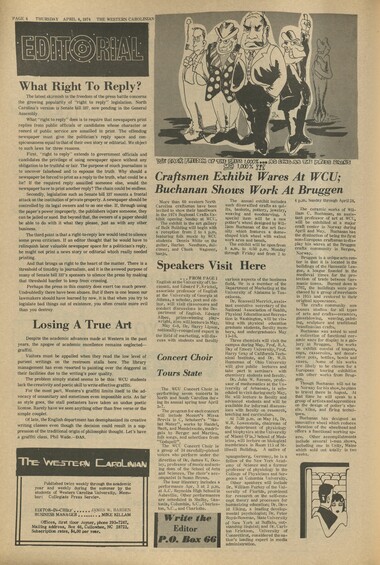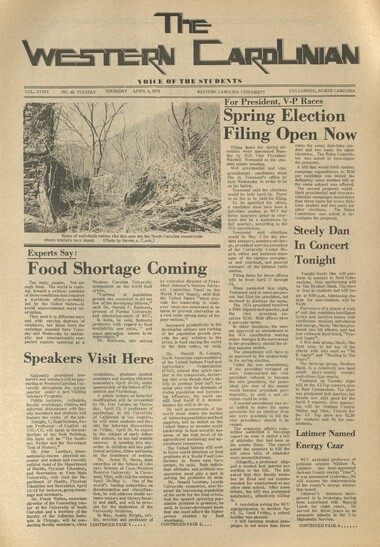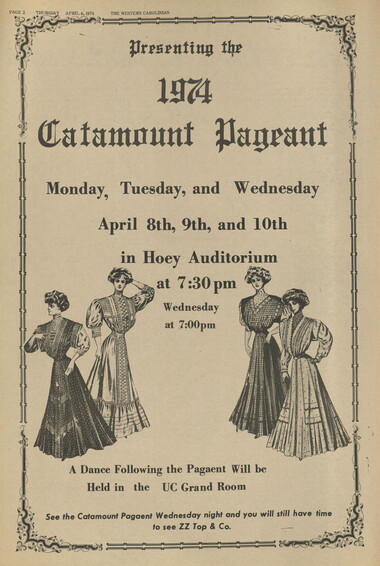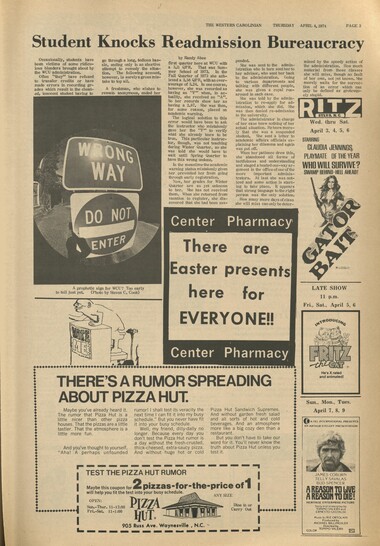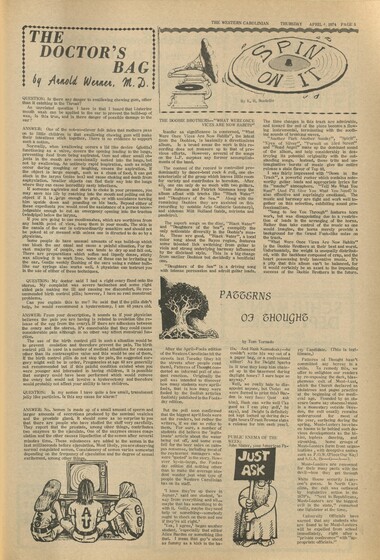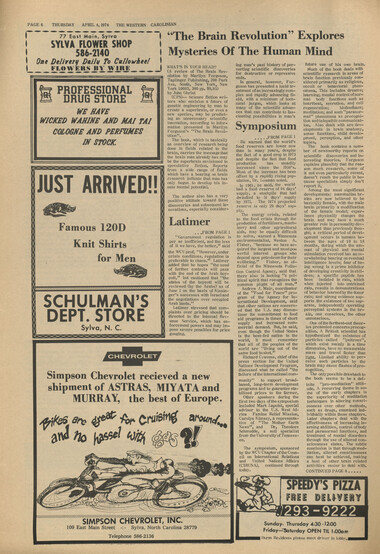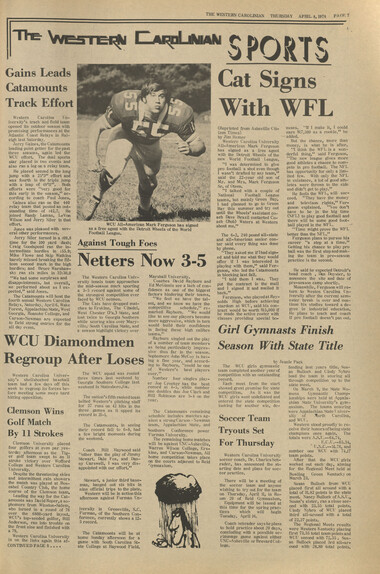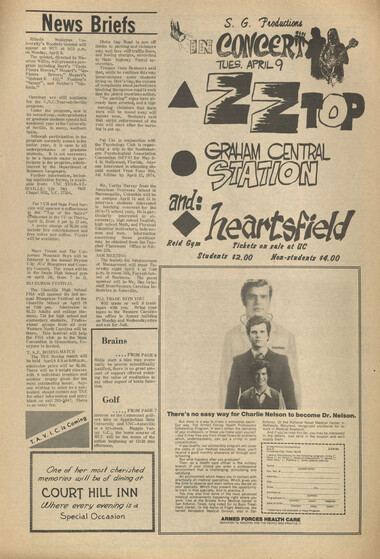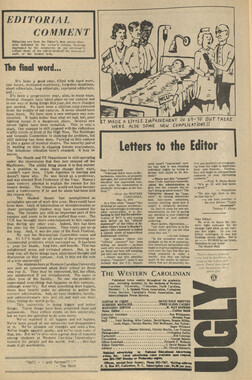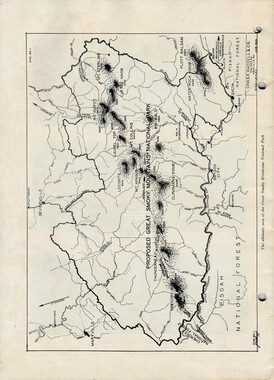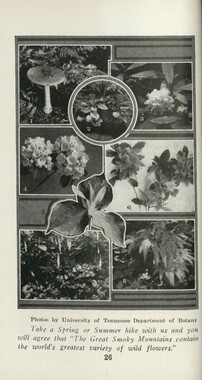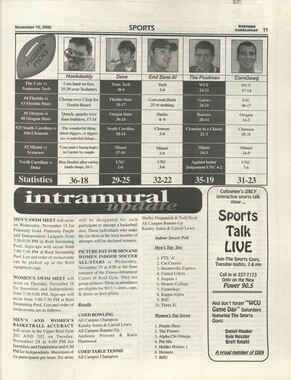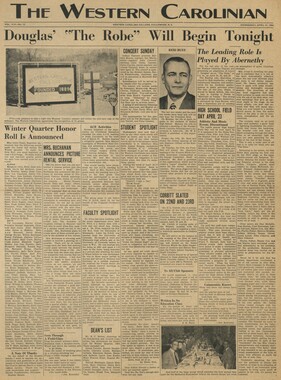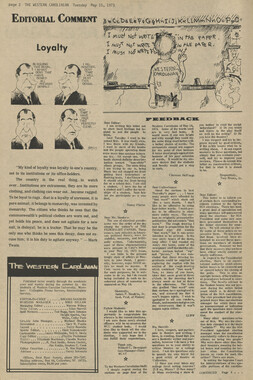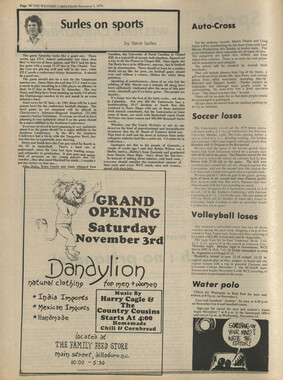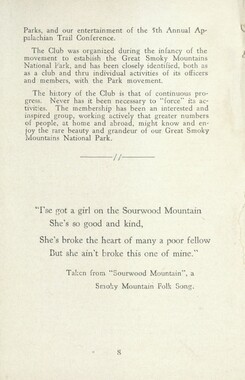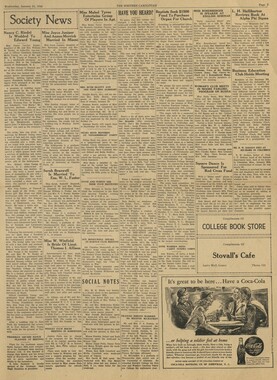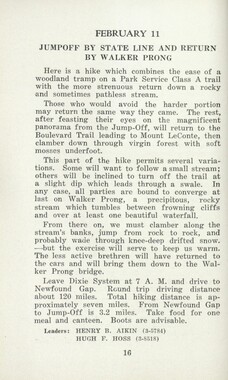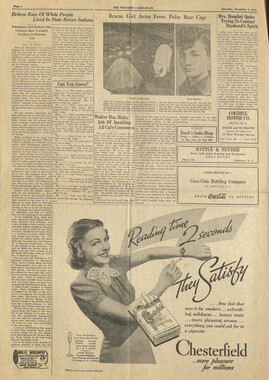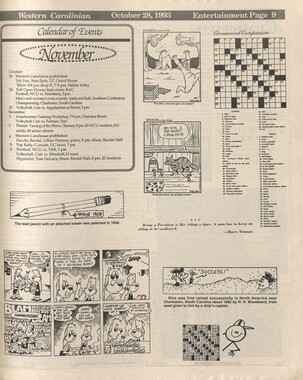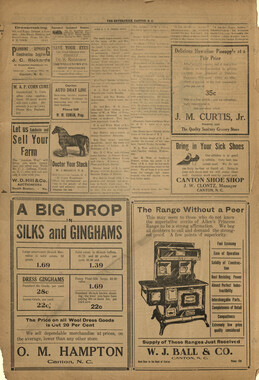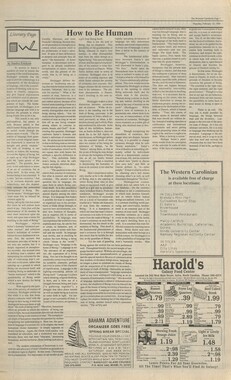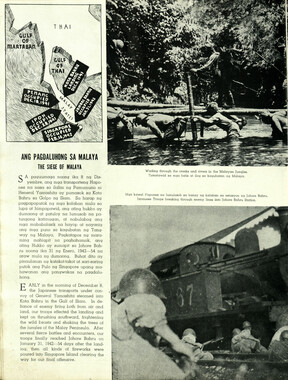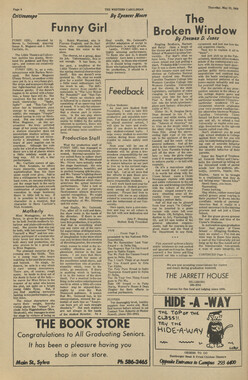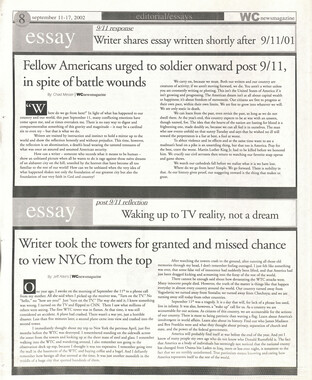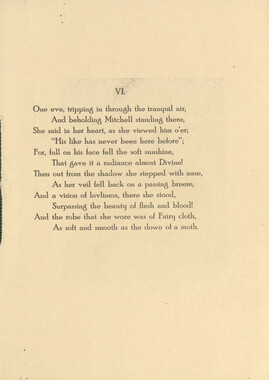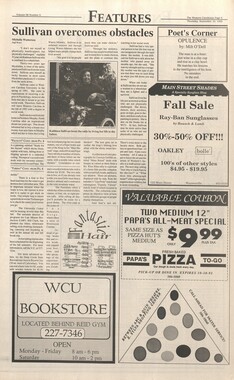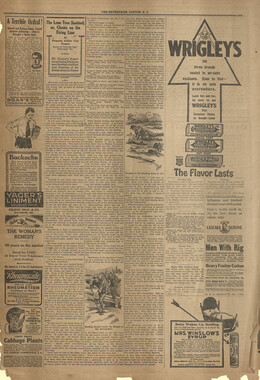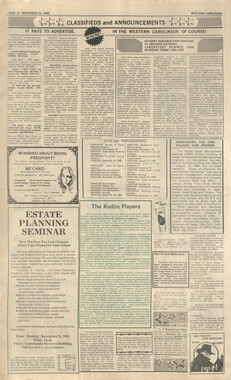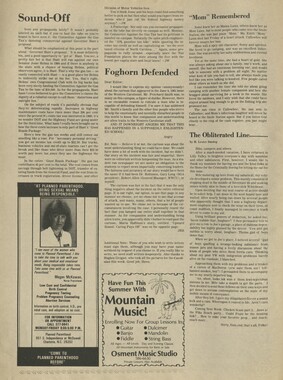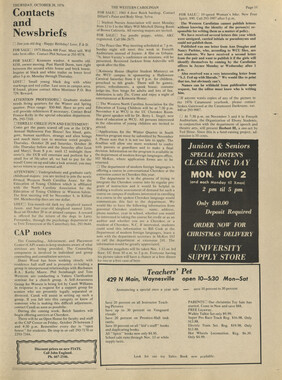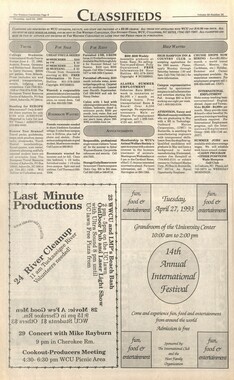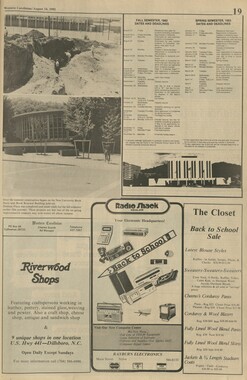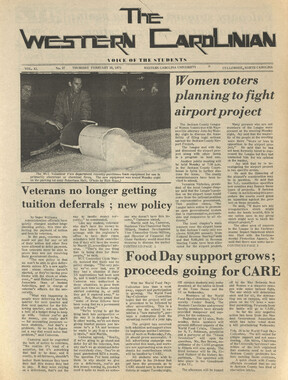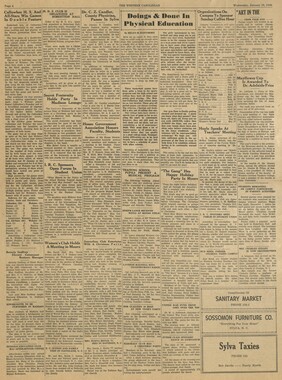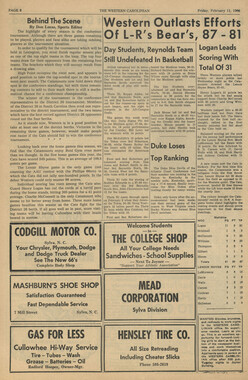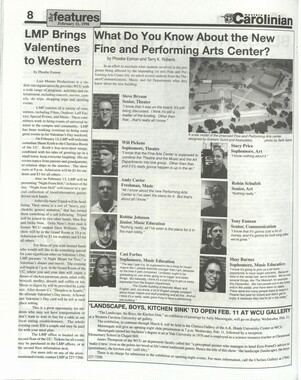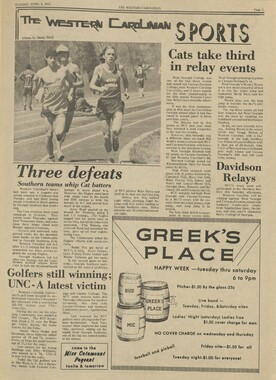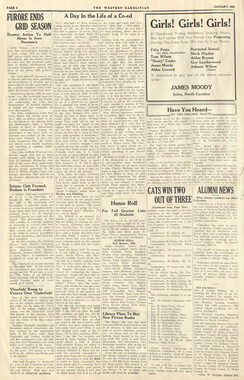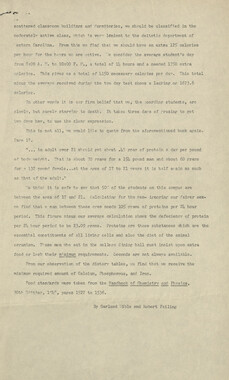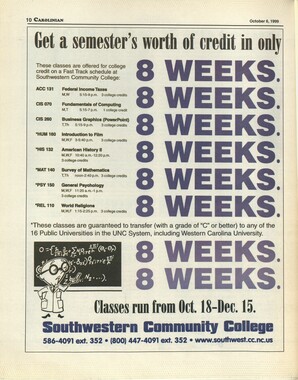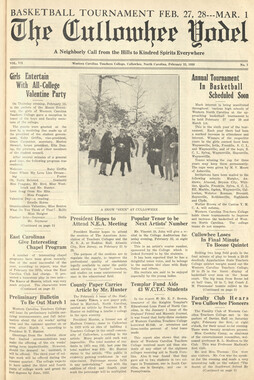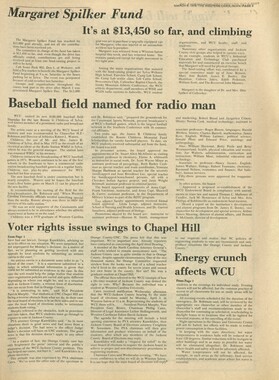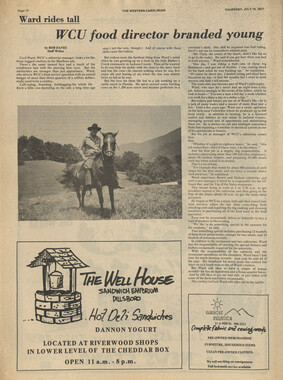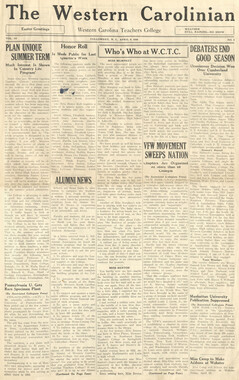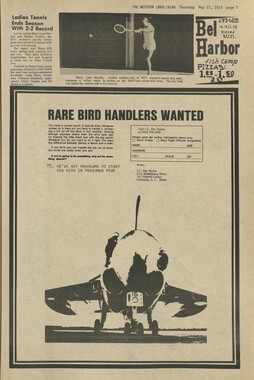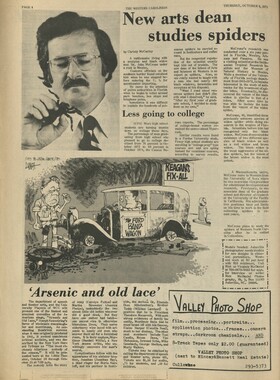Western Carolina University (20)
View all
- Canton Champion Fibre Company (2308)
- Cherokee Traditions (293)
- Civil War in Southern Appalachia (165)
- Craft Revival (1942)
- Great Smoky Mountains - A Park for America (2767)
- Highlights from Western Carolina University (430)
- Horace Kephart (941)
- Journeys Through Jackson (154)
- LGBTQIA+ Archive of Jackson County (26)
- Oral Histories of Western North Carolina (314)
- Picturing Appalachia (6772)
- Stories of Mountain Folk (413)
- Travel Western North Carolina (160)
- Western Carolina University Fine Art Museum Vitreograph Collection (129)
- Western Carolina University Herbarium (92)
- Western Carolina University: Making Memories (708)
- Western Carolina University Publications (2283)
- Western Carolina University Restricted Electronic Theses and Dissertations (146)
- Western North Carolina Regional Maps (71)
- World War II in Southern Appalachia (131)
University of North Carolina Asheville (6)
View all
- Allanstand Cottage Industries (62)
- Appalachian National Park Association (53)
- Bennett, Kelly, 1890-1974 (1388)
- Berry, Walter (76)
- Brasstown Carvers (40)
- Carver, George Washington, 1864?-1943 (26)
- Cathey, Joseph, 1803-1874 (1)
- Champion Fibre Company (233)
- Champion Paper and Fibre Company (297)
- Cherokee Indian Fair Association (16)
- Cherokee Language Program (22)
- Crowe, Amanda (40)
- Edmonston, Thomas Benton, 1842-1907 (7)
- Ensley, A. L. (Abraham Lincoln), 1865-1948 (275)
- Fromer, Irving Rhodes, 1913-1994 (70)
- George Butz (BFS 1907) (46)
- Goodrich, Frances Louisa (120)
- Grant, George Alexander, 1891-1964 (96)
- Heard, Marian Gladys (60)
- Kephart, Calvin, 1883-1969 (15)
- Kephart, Horace, 1862-1931 (313)
- Kephart, Laura, 1862-1954 (39)
- Laney, Gideon Thomas, 1889-1976 (439)
- Masa, George, 1881-1933 (61)
- McElhinney, William Julian, 1896-1953 (44)
- Niggli, Josephina, 1910-1983 (10)
- North Carolina Park Commission (105)
- Osborne, Kezia Stradley (9)
- Owens, Samuel Robert, 1918-1995 (11)
- Penland Weavers and Potters (36)
- Roberts, Vivienne (15)
- Roth, Albert, 1890-1974 (142)
- Schenck, Carl Alwin, 1868-1955 (1)
- Sherrill's Photography Studio (2565)
- Southern Highland Handicraft Guild (127)
- Southern Highlanders, Inc. (71)
- Stalcup, Jesse Bryson (46)
- Stearns, I. K. (213)
- Thompson, James Edward, 1880-1976 (226)
- United States. Indian Arts and Crafts Board (130)
- USFS (683)
- Vance, Zebulon Baird, 1830-1894 (1)
- Weaver, Zebulon, 1872-1948 (58)
- Western Carolina College (230)
- Western Carolina Teachers College (282)
- Western Carolina University (1794)
- Western Carolina University. Mountain Heritage Center (18)
- Whitman, Walt, 1819-1892 (10)
- Wilburn, Hiram Coleman, 1880-1967 (73)
- Williams, Isadora (3)
- Cain, Doreyl Ammons (0)
- Crittenden, Lorraine (0)
- Rhodes, Judy (0)
- Smith, Edward Clark (0)
- Appalachian Region, Southern (2399)
- Asheville (N.C.) (1917)
- Avery County (N.C.) (26)
- Blount County (Tenn.) (161)
- Buncombe County (N.C.) (1671)
- Cherokee County (N.C.) (283)
- Clay County (N.C.) (555)
- Graham County (N.C.) (233)
- Great Smoky Mountains National Park (N.C. and Tenn.) (510)
- Haywood County (N.C.) (3522)
- Henderson County (N.C.) (70)
- Jackson County (N.C.) (4692)
- Knox County (Tenn.) (25)
- Knoxville (Tenn.) (12)
- Lake Santeetlah (N.C.) (10)
- Macon County (N.C.) (420)
- Madison County (N.C.) (211)
- McDowell County (N.C.) (39)
- Mitchell County (N.C.) (132)
- Polk County (N.C.) (35)
- Qualla Boundary (981)
- Rutherford County (N.C.) (76)
- Swain County (N.C.) (2113)
- Transylvania County (N.C.) (247)
- Watauga County (N.C.) (12)
- Waynesville (N.C.) (73)
- Yancey County (N.C.) (72)
- Aerial Photographs (3)
- Aerial Views (60)
- Albums (books) (4)
- Articles (1)
- Artifacts (object Genre) (228)
- Bibliographies (1)
- Biography (general Genre) (2)
- Cards (information Artifacts) (38)
- Clippings (information Artifacts) (191)
- Crafts (art Genres) (622)
- Depictions (visual Works) (21)
- Design Drawings (1)
- Drawings (visual Works) (184)
- Envelopes (73)
- Facsimiles (reproductions) (1)
- Fiction (general Genre) (4)
- Financial Records (12)
- Fliers (printed Matter) (67)
- Glass Plate Negatives (381)
- Guidebooks (2)
- Internegatives (10)
- Interviews (812)
- Land Surveys (102)
- Letters (correspondence) (1013)
- Manuscripts (documents) (619)
- Maps (documents) (177)
- Memorandums (25)
- Minutes (administrative Records) (59)
- Negatives (photographs) (5835)
- Newsletters (1285)
- Newspapers (2)
- Occupation Currency (1)
- Paintings (visual Works) (1)
- Pen And Ink Drawings (1)
- Periodicals (193)
- Personal Narratives (10)
- Photographs (12976)
- Plans (maps) (1)
- Poetry (7)
- Portraits (1960)
- Postcards (329)
- Programs (documents) (151)
- Publications (documents) (2237)
- Questionnaires (65)
- Scrapbooks (282)
- Sheet Music (2)
- Slides (photographs) (402)
- Songs (musical Compositions) (2)
- Sound Recordings (796)
- Specimens (92)
- Speeches (documents) (15)
- Tintypes (photographs) (8)
- Transcripts (322)
- Video Recordings (physical Artifacts) (23)
- Vitreographs (129)
- Text Messages (0)
- A.L. Ensley Collection (275)
- Appalachian Industrial School Records (7)
- Appalachian National Park Association Records (336)
- Axley-Meroney Collection (2)
- Bayard Wootten Photograph Collection (20)
- Bethel Rural Community Organization Collection (7)
- Blumer Collection (5)
- C.W. Slagle Collection (20)
- Canton Area Historical Museum (2110)
- Carlos C. Campbell Collection (282)
- Cataloochee History Project (65)
- Cherokee Studies Collection (4)
- Daisy Dame Photograph Album (5)
- Daniel Boone VI Collection (1)
- Doris Ulmann Photograph Collection (112)
- Elizabeth H. Lasley Collection (1)
- Elizabeth Woolworth Szold Fleharty Collection (4)
- Frank Fry Collection (95)
- George Masa Collection (173)
- Gideon Laney Collection (452)
- Hazel Scarborough Collection (2)
- Hiram C. Wilburn Papers (28)
- Historic Photographs Collection (236)
- Horace Kephart Collection (861)
- Humbard Collection (33)
- Hunter and Weaver Families Collection (1)
- I. D. Blumenthal Collection (4)
- Isadora Williams Collection (4)
- Jesse Bryson Stalcup Collection (47)
- Jim Thompson Collection (224)
- John B. Battle Collection (7)
- John C. Campbell Folk School Records (80)
- John Parris Collection (6)
- Judaculla Rock project (2)
- Kelly Bennett Collection (1407)
- Love Family Papers (11)
- Major Wiley Parris Civil War Letters (3)
- Map Collection (12)
- McFee-Misemer Civil War Letters (34)
- Mountain Heritage Center Collection (4)
- Norburn - Robertson - Thomson Families Collection (44)
- Pauline Hood Collection (7)
- Pre-Guild Collection (2)
- Qualla Arts and Crafts Mutual Collection (12)
- R.A. Romanes Collection (681)
- Rosser H. Taylor Collection (1)
- Samuel Robert Owens Collection (94)
- Sara Madison Collection (144)
- Sherrill Studio Photo Collection (2558)
- Smoky Mountains Hiking Club Collection (616)
- Stories of Mountain Folk - Radio Programs (374)
- The Reporter, Western Carolina University (510)
- Venoy and Elizabeth Reed Collection (16)
- WCU Gender and Sexuality Oral History Project (32)
- WCU Mountain Heritage Center Oral Histories (25)
- WCU Oral History Collection - Mountain People, Mountain Lives (71)
- WCU Students Newspapers Collection (1744)
- Western North Carolina Tomorrow Black Oral History Project (69)
- William Williams Stringfield Collection (2)
- Zebulon Weaver Collection (109)
- African Americans (390)
- Appalachian Trail (35)
- Artisans (521)
- Cherokee art (84)
- Cherokee artists -- North Carolina (10)
- Cherokee language (21)
- Cherokee pottery (101)
- Cherokee women (208)
- Church buildings (167)
- Civilian Conservation Corps (U.S.) (110)
- College student newspapers and periodicals (1830)
- Dams (103)
- Dance (1023)
- Education (222)
- Floods (61)
- Folk music (1015)
- Forced removal, 1813-1903 (2)
- Forest conservation (220)
- Forests and forestry (1058)
- Gender nonconformity (4)
- Great Smoky Mountains National Park (N.C. and Tenn.) (181)
- Hunting (38)
- Landscape photography (10)
- Logging (103)
- Maps (84)
- Mines and mineral resources (8)
- North Carolina -- Maps (18)
- Paper industry (38)
- Postcards (255)
- Pottery (135)
- Railroad trains (71)
- Rural electrification -- North Carolina, Western (3)
- School integration -- Southern States (2)
- Segregation -- North Carolina, Western (5)
- Slavery (5)
- Sports (452)
- Storytelling (245)
- Waterfalls -- Great Smoky Mountains (N.C. and Tenn.) (66)
- Weaving -- Appalachian Region, Southern (280)
- Wood-carving -- Appalachian Region, Southern (328)
- World War, 1939-1945 (173)
Western Carolinian Volume 39 Number 48
Item
Item’s are ‘child’ level descriptions to ‘parent’ objects, (e.g. one page of a whole book).
-
-
PAGE 4 THURSDAY APRIL 4, 1974 THE WESTERN CAROLINIAN What Right To Reply? The latest skirmish in the freedom of the press battle concerns the growing popularity of "right to reply" legislation. North Carolina's version is Senate bill 337, now pending in the General Assembly. What "right to reply" does is to require that newspapers print replies from public officials or candidates whose character or record of public service are assailled in print. The offending newspaper must give the politician's reply space and con- spicuousness equal to that of their own story or editorial. We object to such laws for three reasons. First, "right to reply" extends to government officials and candidates the privilege of using newspaper space without any obligation to be truthful or fair. The purpose of much journalism is to uncover falsehood and to espouse the truth. Why should a newspaper be forced to print as a reply to the truth, what could be a lie? If the required reply assailled someone else, would the newspaper have to print another reply? The chain could be endless. Secondly, legislation such as Senate bill 337 mounts a frontal attack on the institution of private property. A newspaper should be controlled by its legal owners and to no one else. If, through using the paper's power improperly, the publishers injure someone, they can be jailed or sued. But beyond that, the owners of a paper should be able to do with it what they please, just as with any other business. The third point is that a right-to-reply law would tend to silence some press criticism. If an editor thought that he would have to relinquish later valuable newspaper space for a politician's reply, he might not print a news story or editorial which really needed printing. And that brings us right to the heart of the matter. There is a threshold of timidity in journalism, and it is the avowed purpose of many of Senate bill 337's sponsors to silence the press by making that threshold harder to keep from crossing. Perhaps the press in this country does exert too much power. Undoubtedly there have been abuses. But if there is one lesson our lawmakers should have learned by now, it is that when you try to legislate bad things out of existence, you often create more evil than you destroy. Losing A True Art Despite the academic advances made at Western in the past years, the apogee of academic excellence remains neglected— graffiti. Visitors must be appalled when they read the low level of purient writings on the restroom stalls here. The library management has even resorted to painting over the doggerel in their facilities due to the writing's poor quality. The problem simply stated seems to be this: WCU students lack the creativity and poetic skill to write effective graffiti. For the most part, Western's graffiti limits itself to the advocacy of unsanitary and sometimes even impossible acts. As far as style goes, the stall poetasters have taken an undue poetic license. Rarely have we seen anything other than free verse or the simple couplet. Of late, the English department has deemphasized its creative writing classes even though the decision could result in a suppression of the traditional origin of philosophic thought. Let's have a graffiti class, Phil Wade.—DAS. Thmzr \/Vi=5Tf=^ CAI^lLlMlAiSl Published twice weekly through the academic year and weekly during the summer by the students of Western Carolina University. Member: Collegiate Press Servic. EDITOR-IN-CHIKF JAMES W. BARDEN BUSINESS MANAGER ..'. .MIKE KILLAM Offices, first floor Joyner, phone 293-7267. Mailing address, Box 66, Cullowhee, NC 28723. Subscription rates, $4.00 per year. WS 0£g& H33£SGa W^BB 1,000% iii Craftsmen Exhibit Wares At WCU; Buchanan Shows Work At Bruggen More than 60 western North Carolina craftsmen have been invited to show their handiwork in the 1974 Regional Crafts Exhibit opening Sunday at WCC. The exhibit in the art gallery of Belk Building will begin with a reception from 2 to 4 p.m. featuring folk music by WCU students Dennis White on the guitar, Harlan Needham, dulcimer; and Chuck Wagoner, banjo. The annual exhibit includes such diversified crafts as quilts, baskets, pottery, jewelry, weaving and woodcarving. A special item will be a new potter's wheel designed by William Buchanan of the art faculty which features a dome- shaped kick wheel with walnut work area and bench. The exhibit will be open from 8 a.m. to 4:30 p.m. Monday- through Friday and from 2 to Speakers Visit Here . . . FROM PAGE 1 English atthe University of Cincinnati, and Edward F.Krickel, associate professor of English at the University of Georgia at Athens, a scholar, poet and editor, will visit classrooms and conduct discussions in the Department of English. Edward Albee, prize-winning playwright, also will lecture in Mav. May 6-8, Dr. Harry Lipson, nationally-recognized expert in the field of marketing, will discuss with students and faculty Concert Choir Tours State The WCU Concert Choir is performing seven concerts in North and South Carolina during its annual spring tour April 3-7. The program for each concert will include Mozart's Missa Brevis in C, Schubert's "Sta- bat Mater", works by Handel, Bach, and Mendelssohn, madrigals by Berger and Martinu, folk songs, and selections from "Godspell". The WCU Concert Choir is a group of 34 carefully-picked voices who perform under the direction of Dr. James E. Doo- ley, professor of music and acting dean of the School of Arts and Sciences. The choir's accompanist is Susan Brown. The tour itinerary includes a performance Apr. 3 at 2 p.m. at A.C. Reynolds High School in Asheville. Other performances are scheduled in Shelby, Gas- tonia, Columbia, S.C,Charleston, S.C, and Charlotte. Write thel Editor various aspects of the business field. He is a member of the Department of Marketing at the University of Alabama in Tuscaloosa. Dr. RosswellMerrick, assistant executive secretary of the National Association of Health, Physical Education and Recreation in Washington, will be visiting with physical education graduate students, faculty mem= bers, and undergraduates May 13-16. Three chemists will visit the campus during May. Prof. R.A. Day of Emory University, Prof. Harry Gray of California Technical Institute, and Dr. W.D0 Huntsman of Ohio University will give public lectures and take part in seminars with chemistry students and faculty. Dr. John W. Keesee, professor of mathematics at the University of Arkansas, is scheduled to visit during early May. He will lecture to faculty and advanced students and will be available for informal discussions with faculty on research, teaching and curriculum. At 7:30 p.m. on May 16, Dr. W.R„ Lowenstein, chairman of the department of physiology and biophysics atthe University of Miami (Fla.) School of Medicine, will lecture on biological membranes in Room 115 of Stillwell Building. A native of Spangenberg, Germany, he is a fellow of the New York Academy of Science and a former professor of physiology in the College of Physicians and Surgeons at Columbia University. Other speakers will include Dr. William Purkey of the University of Florida, prominent for research on the self-concept theory and processes for humanizing education; Dr. David Elking, a leading developmental psychologist; Dr. Peter Boyd-Bowman, State University of New York at Buffalo, outstanding linguist; and Dr. Carlton Erickson, University of Connecticut, considered the nation's leading expert in media administration. 4 p.m. Sunday through April 28. The ceramic works of William C Buchanan, an assistant professor of art at WCU, will be exhibited at a major craft center in Norway during April and May. Buchanan has the distinction of being the first non-European craftsman to display his wares at the Bruggen crafts community in Bergen, Norway. Bruggen is a unique arts center in that it is located in the buildings of the Hanseatic League, a league founded in the medieval times for the protection of trade between Germanic towns. Burned down in 1702, the buildings were purchased by a group of merchants in 1955 and restored to their original appearance. The crafts community now houses studios for all types of arts and crafts—ceramics, glassblowing, weaving, painting, sculpture and traditional Scandinavian crafts. Buchanan was asked to send a collection of functional ceramic ware for display in a gallery at Bruggen. The works on exhibit consist of teapots, cups, casseroles, and decorative pots, bottles, bowls and vases. Some of his works are likely to be chosen for a European touring exhibition with other works from Bruggen. Though Buchanan will not be in Norway for his show, he plans to travel there in August. At that time he will speak to a group of artists and apprentices on the design of potter's wheels, kilns, and firing techniques. Buchanan has designed an innovative wheel which reduces vibration of the wheelhead and offers a functional working space. Other accomplishments include several 1-man shows, including one in Unity, Maine which sold out totally in two weeks.
Object
Object’s are ‘parent’ level descriptions to ‘children’ items, (e.g. a book with pages).
-
The Western Carolinian is Western Carolina University's student-run newspaper. The paper was published as the Cullowhee Yodel from 1924 to 1931 before changing its name to The Western Carolinian in 1933.
-
